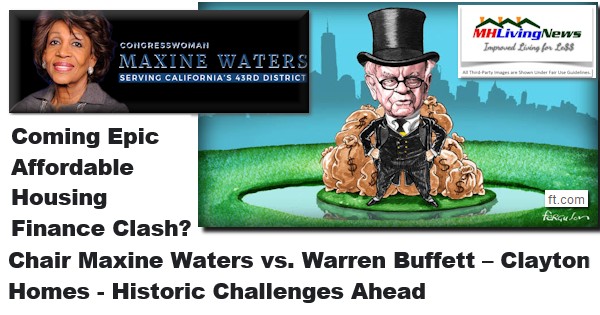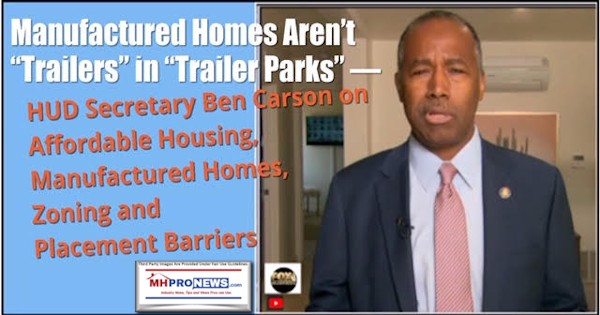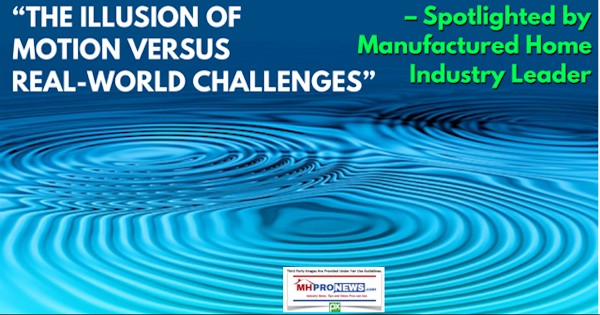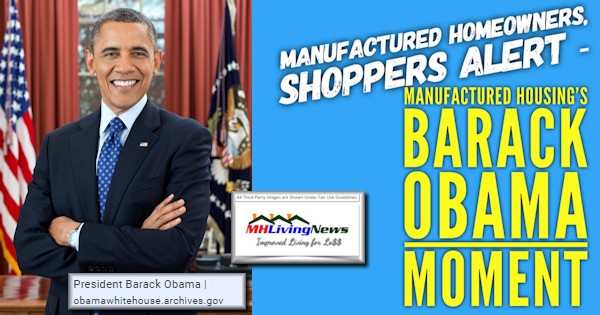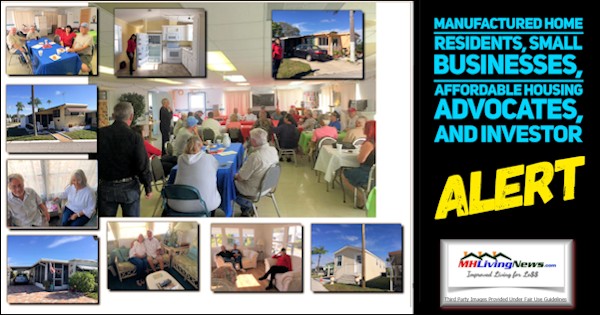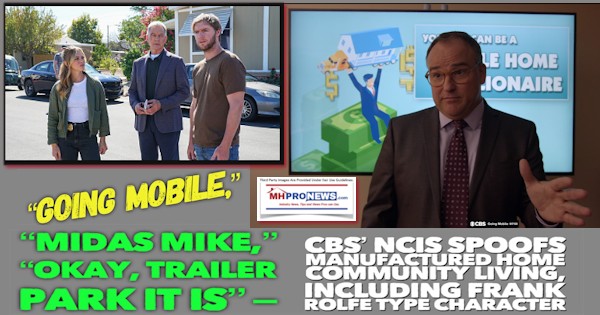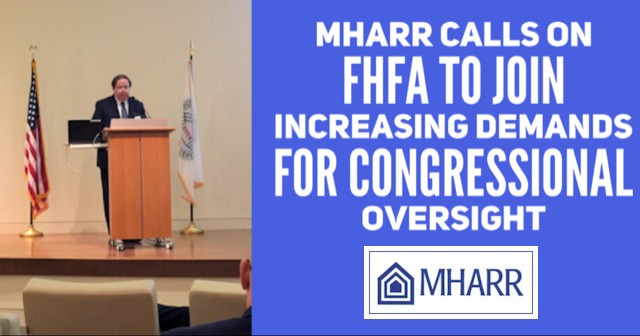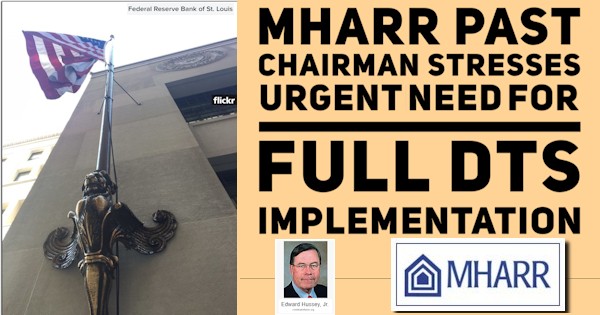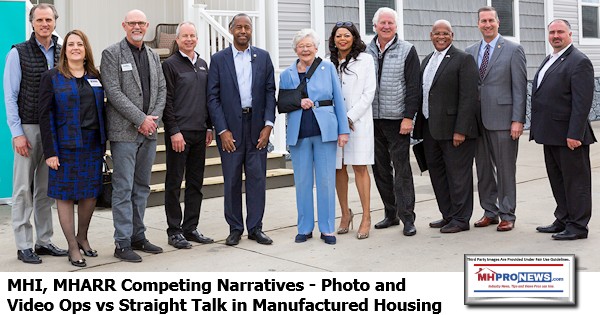
This report will proceed with the following systematic segments.
- Part 1. This preface and a related link.
- Part 2. Items from the Manufactured Housing Institute (MHI) in their recent email ‘news and updates.’
- Part 3. The corresponding report on the same date from the Manufactured Housing Association for Regulatory Reform (MHARR).
- Part 4. MHProNews Analysis and Commentary, which will include a teaser for a looming revelation.
Part 1. Preface and Related Link
The runaway number 1 report in months on MHProNews was this past weekend. It is the one linked below. It also happens to be related to a topic that MHI has raised. If you are among those that haven’t read this yet, it would be helpful to do so now.
That report linked above provides a granular context to what MHI put forth on 2.5.2020 via an email to their members, the related portion of which is found below.
Part 2. Items from the Manufactured Housing Institute (MHI) on 2.5.2020 via an email to their members.
MHI Joins HUD, Clayton to Kick Off Multi-City HUD Bus Tour

This is among the first stops on HUD’s “Driving Affordable Housing Across America,” a multi-city bus tour which will run throughout the early months of 2020. In addition to touring the facility, Sec. Carson took questions during an employee town hall.

In the photo above –
Left to right – Keith Holdbrooks, Kevin Clayton – Clayton Homes. HUD Secretary Ben Carson speaking. What this photo demonstrates is quite different than what MHI and Clayton may want. Clearly, they have proven time and again that they have good access to key public officials. Given that federal law for almost 2 decades says that HUD Code manufactured homes enjoyed “enhanced preemption” why hasn’t MHI, Clayton, et al pressed HUD to enforce existing laws? Why is there no mention of that or the FHFA meeting in the MHI 2.5.2020 emailed ‘news’ to their members? Photo ops and videos can be part of the ‘razzle dazzle’ method of impressing people but focus on the outcomes not the images. Don’t be surprised if this and other images like it appear more with MHI, Clayton Homes, et al. Photo credit, MHI.

Next, compare those topics from MHI to what follows from MHARR. Keep in mind that following the MHARR report, there will be an analysis of these items.
Part 3. The corresponding report on the same date from the Manufactured Housing Association for Regulatory Reform (MHARR).
Note that the following includes the DTS report that MHProNews individually focused on yesterday, which is found at this link here and further below.
MHARR February 5, 2020 Washington Update – Report and Analysis
REPORT AND ANALYSIS
IN THIS REPORT: FEBRUARY 5, 2020
- PRESIDENTS’ ORDERS SUPPORT MHARR ON “GUIDANCE” LETTERS
- MHARR WINS FIRST ROUND OF HUD FOIA APPEAL ON MHCC
- MHARR CONTINUES TO EXPOSE FANNIE AND FREDDIE SCHEMES
- MHARR SEEKS DECISIVE ACTION BY WHITE HOUSE COUNCIL
- MHCC SUBCOMMITTEE RECOMMENDS ON-SITE CHANGES
- 2020 HALL OF FAME CLASS OMITS HUD CODE MANUFACTURERS
- DOE ISSUES NEW “PROCESS” RULE FOR CERTAIN ENERGY STANDARDS

Two Executive Orders (EOs) issued by President Trump strongly support MHARR’s longstanding position that the HUD manufactured housing program may not impose binding new regulatory mandates on manufacturers (or other regulated parties) through “guidance letters” or “interpretations” issued without prior Manufactured Housing Consensus Committee (MHCC) review and notice and comment rulemaking as required by law. The two Orders, EO 13891 (“Promoting the Rule of Law Through Improved Agency Guidance Documents”) and EO 13892 (“Promoting the Rule of Law Through Transparency and Fairness in Civil Administrative Enforcement and Adjudication”), are designed to eliminate the abuse of non-published, sub-regulatory “guidance” memoranda and similar pronouncements, issued without notice and comment rulemaking, to change the obligations and responsibilities of regulated parties or to establish completely new de facto regulations.
Federal manufactured housing law — and especially the Manufactured Housing Improvement Act of 2000 — has always been clear that HUD cannot use such sub-regulatory procedures. HUD, however, and all too often with the tacit approval of some in the industry, has long sought to evade and circumvent these requirements. The program, as a result, has spent much of the past 20 years operating in direct violation of the clear language of the law while giving short-shrift to the MHCC, all to the detriment of the industry – and particularly its smaller businesses – and the millions of Americans in need of affordable, non-subsidized home ownership.
Now, though, these abuses have been expressly rejected by the Trump Administration, while the validity of MHARR’s longstanding objections and opposition to them have been made absolutely clear. EO 13891 thus provides: “[I]t is the policy of the Executive Branch … to require that agencies treat guidance documents as non-binding both in law and in practice…. Agencies may impose legally binding requirements on the public only through regulations … and only after appropriate process….” (Emphasis added). EO 13892 further states: “Guidance documents may not be used to impose new standards of conduct on persons outside the Executive Branch except as expressly authorized by law…. The agency may not treat noncompliance with a standard of conduct announced solely in a guidance document as itself a violation of applicable statutes or regulations.” (Emphasis added).
EOs 13891 and 13892 thus confirm that the 2000 reform law means what it says about prior MHCC review and notice and comment rulemaking for all HUD actions specified in sections 604(a) (i.e., standards) and 604(b) (i.e., enforcement regulations, Interpretive Bulletins and changes to policies, procedures and practices affecting the standards, enforcement and monitoring). Retrospectively, this means that all HUD manufactured housing program “guidance” documents and similar “operating procedures” adopted since the effective date of the 2000 reform law without Manufactured Housing Consensus Committee (MHCC) review and notice and comment rulemaking as required by that law, are “non-binding” and thus unenforceable. Prospectively, it means that HUD (during the Trump Administration) may not impose any new binding requirements through the manufactured housing program via “guidance” documents or other pronouncements which have not been considered and recommended by the MHCC and published for notice and comment. Both of these impacts are more fully examined in the January 2020 issue of “MHARR – Issues and Perspectives.”
MHARR, meanwhile, in comments to HUD, the White House Council on Eliminating Regulatory Barriers to Affordable Housing and the MHCC, has made it clear that the policy enunciated in these EOs is binding on all HUD actions relating to the federal manufactured housing program and that strong remedial action is necessary to eliminate both the ongoing negative impacts of previous unlawful HUD pseudo-regulatory actions and to prevent any such unlawful actions in the future. This is particularly important in light of moves by the HUD manufactured housing program, under its current career administrator, to gradually weaken the MHCC and slant its procedures in order to prevent full participation and input by all interested parties. (See, article below).
MHARR WINS FIRST ROUND OF HUD FOIA APPEAL ON MHCC
MHARR has won the opening round of an administrative appeal over a HUD decision refusing to disclose information related to the selection of members to serve on the Manufactured Housing Consensus Committee.
In a Freedom of Information Act (FOIA) request filed in January 2016, MHARR had sought the disclosure of all applications for appointment to the statutory MHCC – regardless of whether the applicant was actually appointed by HUD – filed since January 2008. The purpose of this request was to: (1) determine whether all MHCC appointees had been selected by HUD in accordance with all applicable requirements and criteria of the Manufactured Housing Improvement Act of 2000; and (2) to determine whether there is evidence of past or present discrimination by HUD, or potential HUD bias, against any individual(s), group, class, or interest in the selection (or non-selection) of MHCC members. This information and its related assessment is of crucial importance not only given the central role of the MHCC in the HUD regulatory process, but its weakening and manipulation by HUD, and is entirely consistent with the policies of President Trump regarding potential abuses of federal regulatory power and related processes.
In a September 2019 response to this request, HUD disclosed the nomination applications submitted by individuals previously appointed to the MHCC, but refused to produce applications submitted by persons not yet appointed to the MHCC, citing FOIA Exemption 6, protecting personal privacy interests.
In its administrative appeal, MHARR asserted that non-appointed nominees have no reasonable expectation of privacy in their nomination forms that is legitimately distinguishable from those who have been appointed to the MHCC, and that all such applications must be disclosed in order to determine if HUD, in the MHCC selection process, is excluding certain parties and/or interests from full representation, or is discriminating or otherwise playing favorites in its selection process. The significance and relevance of this inquiry has only grown in light of recent actions by the HUD program to unduly and improperly restrict the participation rights of non-MHCC members in MHCC debates and in the MHCC’s consideration of proposals that are of vital interest to both the industry and consumers. Such increasing efforts to silence participation by interested parties and exclude historically relevant information regarding, among other things, regulatory cost versus consumer benefit information, is reminiscent of similar activity by the Department in connection with the failed and bankrupt “Manufactured Housing Advisory Council,” which Congress, in the 2000 reform law, terminated in favor of a fully-functional and fully-accountable MHCC. Any step backward in that direction is wholly unacceptable to MHARR and will be targeted for appropriate action.
In a decision issued January 29, 2020, HUD’s Office of Ethics, Appeals and Personnel Law ruled that FOIA “Exemption 6 does not support the withholding of the entire applications of those applicants not selected.” As a result, that office remanded MHARR’s request to HUD’s FOIA office for “reprocessing in accordance with [its] appeal determination.” Consistent with this action, MHARR will now seek a full response to this inquiry and will take further steps as necessary to ensure that HUD fully complies.
MHARR CONTINUES TO PRESS FANNIE AND FREDDIE ON DTS
MHARR, at a February 4, 2020 meeting with Federal Housing Finance Agency (FHFA) Director Mark Calabria and other senior officials, called for an end to more than a decade of delays, diversions, outright defiance and other false starts that have left the vast bulk of the mainstream HUD Code manufactured housing consumer finance market completely unserved by both Fannie Mae and Freddie Mac, notwithstanding the congressional mandate of the Duty to Serve Underserved Markets (DTS) provision of the Housing and Economic Recovery Act of 2008 (HERA).
The meeting, which included representatives of organizations that had offered testimony regarding DTS and the manufactured housing consumer finance market at a series of FHFA-DTS “listening sessions” in late 2019, specifically addressed DTS in relation to the large segment of the HUD Code manufactured housing market – nearly 80% according to U.S. Census Bureau statistics – that relies on and utilizes home-only “chattel” or personal property financing.
Despite the fact that personal property loans represent the vast majority of mainstream HUD Code manufactured housing consumer loans and offer moderate and lower-income American families access to the industry’s most affordable homes, neither Fannie Mae nor Freddie Mac has provided any securitization or secondary market support for such loans since DTS was enacted over a decade ago.
Instead, the GSEs – with the implicit approval of FHFA — have engaged in an ongoing charade of “information gathering” and “research,” while concrete action to implement DTS for mainstream HUD Code chattel loans has been non-existent. This inaction, while claiming a lack of specific data, effectively forces mainstream HUD Code consumers to seek loans (predominantly) through industry-dominant portfolio lenders that charge higher-cost interest rates than would be the case in a fully-competitive market. This, in turn, undermines any incentive whatsoever for those lenders to share that loan performance and other information with Fannie Mae or Freddie Mac, as a fully-supported and competitive manufactured housing consumer financing market would result in lower interest rates. Meanwhile, the GSEs, with the assistance of the Manufactured Housing Institute (MHI) and the industry’s largest corporate conglomerates, have sought to divert the focus of DTS from mainstream, inherently affordable manufactured housing to a so-called “new class” or “new generation” of manufactured housing (titled as real estate) which is significantly less affordable than mainstream HUD Code manufactured housing.
In response to questions posed by FHFA, MHARR stressed that DTS-based support for mainstream HUD Code manufactured housing chattel loans is absolutely crucial to: (1) the success of DTS as envisioned by Congress; (2) to ensuring that the affordable housing needs of millions of moderate and lower-income Americans are fully-met; and (3) to the future growth, expansion and evolution of the manufactured housing industry. Conversely, MHARR pointed out that without market-significant DTS support for mainstream HUD Code home personal property loans (as has been consistently sought and urged by MHARR), consumers have been forced to pay higher-cost interest rates due to lack of competition, while the market for new HUD Code manufactured homes, as shown by HUD data contracted by 2% in 2019, even as the broader housing market, surged to its highest level of new home starts since 2006.
Meanwhile, MHARR aggressively refuted a baseless allegation by a representative of the National Association of Home Builders (NAHB) that the federal manufactured housing construction and safety standards are somehow deficient as compared with site-building construction codes. This begs the question, however, of why NAHB, a collective organization of manufactured housing industry competitors, that has benefitted lavishly from the support provided through multiple Fannie and Freddie programs and activities, was even invited to – or allowed to attend – a meeting that was expressly focused on HUD Code manufactured home lending under DTS and, more particularly, HUD Code manufactured home personal property consumer lending under DTS. It is particularly egregious that FHFA, while Fannie and Freddie are engaged in an effort to hijack and divert DTS away from affordable, mainstream manufactured housing, would entertain the involvement of industry competitors seeking to maliciously attack the federal standards and the truly affordable, high-quality homes produced thereunder.
Ultimately, MHARR urged FHFA to fulfill its regulatory obligation to ensure that Fannie Mae and Freddie Mac fully comply with all aspects of the DTS law, and if it feels unable to do so, to join with MHARR and others in the growing demand for congressional oversight to put DTS back on track.
MHARR CALLS FOR DECISIVE WHITE HOUSE COUNCIL REFORMS
MHARR, in comments filed on January 9, 2020, has called for decisive action by the White House Council on Eliminating Regulatory Barriers to Affordable Housing (Council) to remove existing and worsening barriers to the availability and utilization of affordable HUD Code manufactured housing. The Council, created by Executive Order 13878 (June 25, 2019) and chaired by HUD Secretary Ben Carson, has been directed by President Trump to “reduce” and “remove” overly burdensome regulatory barriers at the federal, state and local level “that artificially raise the cost of housing” and “cause [a] lack of housing supply.” (Emphasis added). The Council thus represents an unparalleled opportunity for the industry to address – and seek the resolution of – multiple issues that have needlessly stunted its growth, expansion and evolution as a premier source of affordable, unsubsidized homeownership.
MHARR’s comments ask the Council to take specific remedial action in four principal areas: (1) the full and final implementation of all federal manufactured housing program reforms mandated by the Manufactured Housing Improvement Act of 2000; (2) implementation of the 2000 reform law’s enhanced federal preemption provision to invalidate local (or state) zoning or land use laws that discriminatorily exclude or unreasonably restrict the use and/or placement of HUD Code manufactured homes; (3) the rejection of excessive, unnecessary and discriminatory federal manufactured housing energy requirements; and (4) the full, market-significant implementation of the “Duty to Serve Underserved Markets” for all types of manufactured home consumer loans, including the personal property loans that account for nearly 80% of all manufactured home purchases. As the comments explain, each of these matters involve either government action or inaction that severely discriminates against the lower and moderate-income American families that rely the most on affordable HUD Code manufactured housing and smaller, independent industry businesses.
In particular, MHARR’s comments stress that unlike other types of homes, mainstream HUD Code manufactured housing is uniquely within the scope and mission of the White House Council insofar as: (1) it is already the nation’s most affordable type of housing; (2) it is specifically recognized as affordable housing by federal law; (3) federal law is already designed and structured to maintain its inherent affordability; and (4) its production and utilization is directly and comprehensively regulated by the federal government, which is uniquely situated – and directed by federal law — to ensure its continuing affordability.
Because of these factors — and unlike any other type of housing – HUD, and the federal government, more broadly, already have all of the statutory authority they need to “reduce” and ultimately “remove” the regulatory barriers addressed by MHARR which have unnecessarily limited the availability and utilization of inherently affordable manufactured homes by millions of Americans. Thus, the removal of these barriers is not a matter of generating or enacting new laws or regulations with all of the uncertainties and time delays associated with such processes. Instead, as the comments stress, it is simply a matter of implementing – in a full, robust and timely manner – the good laws that the industry has already secured. A copy of MHARR’s comprehensive comments has already been distributed to industry members and the public.
MHCC ADVANCES ON-SITE CONSTRUCTION CHANGES
Consistent with MHARR’s longstanding call for fundamental reforms to the needlessly complex, burdensome and costly “on-site construction” rule adopted by HUD in September 2015, the Manufactured Housing Consensus Committee’s Regulatory Enforcement Subcommittee, during a January 14, 2020 conference call, recommended extensive revisions to that rule and forwarded those recommendations to the full MHCC for further action.
Completing a process that began during the MHCC’s October 2019 meeting in Washington, D.C., the Regulatory Enforcement Subcommittee’s proposed modifications would simplify and streamline certain aspects of the September 2015 HUD rule. That unnecessarily costly rule, as has been consistently stressed by MHARR, has massively expanded and needlessly complicated an earlier MHCC-proposed on-site rule designed to provide a more flexible and less-costly alternative to the cumbersome and time-consuming “Alternative Construction” (AC) process for the completion of conforming manufactured homes at the site of installation.
A key motivation for that original MHCC proposal was a desire to facilitate open and robust free-market competition to unlock an important new market segment for manufactured housing, while allowing consumers to take full advantage of all the unique attributes and benefits of HUD Code manufactured housing. Following extensive, thorough and painstaking debate, a consensus MHCC recommendation was submitted to HUD, finally leading to a proposed on-site construction rule, published in June 2010. The MHCC recommendation, however, upon reaching HUD, was transformed into a distorted, convoluted caricature of pointless paperwork, needless record-keeping, red-tape and duplicative, costly, multi-layered “inspections,” including at least 18 new and separate regulatory mandates and related costs that had not been calculated or even considered by HUD, in direct violation of applicable law. Those additional mandates, though, undermined the site-completion market and pushed manufacturers into the more costly modular housing market in order to meet the needs of consumers seeking certain site-completed amenities.
While the newly-proposed on-site revisions would help ameliorate some of those regulatory burdens and related costs if adopted by HUD, they would still leave in place the 100% final inspection requirement mandated by HUD in its 2015 final rule. As was stressed by MHARR during the initial MHCC rule development process, however, 100% inspections are not necessary to ensure full compliance – which could just as easily be determined through audit-type inspections of a certain percentage of homes — and entails needless expense and delay for consumers. Consequently, as MHARR’s representative indicated at the conclusion of the Subcommittee debate, MHARR will continue to pursue an on-site process which utilizes such audit-type inspections, rather than 100% “blanket” inspections.
2020 HALL OF FAME CLASS OMITS HUD CODE MANUFACTURERS
The 2020 inductees announced recently by the RV/MH Hall of Fame in Elkhart, Indiana, include manufactured housing community operators and association executives, but curiously, not even a single HUD Code manufacturer. Insofar as every aspect of the “manufactured housing” industry is derivative of the home itself, this is akin to a sports Hall of Fame inducting a class that did not include a single player.
Given that: (1) manufacturers represent the essential core of the industry; (2) there are innumerable candidates from the manufacturing sector who are highly-qualified for induction into the Hall of Fame; and (3) indeed, certain manufacturers have previously been nominated — but not selected for induction based on unknown factors and considerations – is it the view of the Hall Foundation that no manufacturers merited entry into the Hall this year?
Whether this is intentional or an oversight, neither bodes well for either the industry or the Hall. Indeed, in a process that is completely non-transparent, there would appear to be legitimate questions with respect to the selection process. Given the importance of the Hall of Fame and the stature of the Foundation, it is incumbent on the Foundation to provide a clear, legitimate and public explanation of this critical omission.
MHARR, for some time now, has sought to explore these questions and concerns in a quiet and cooperative manner with Hall officials, but real answers have not been forthcoming. For the sake of all concerned, the Hall Foundation should err on the side of transparency and legitimacy.
DOE ISSUES “PROCESS” RULE FOR CERTAIN ENERGY STANDARDS
The U.S. Department of Energy (DOE), on January 15, 2020, announced the publication of its new “process” rule for the adoption and modification of energy standards and related test procedures for “consumer products” and “commercial/industrial equipment.”
Because: (1) it was not clear at the inception of this rulemaking process whether these new procedures would be applicable to potential DOE energy standards for manufactured homes; and (2) because MHARR wished to utilize this rulemaking to re-assert and re-emphasize the fundamental illegitimacy of DOE’s fatally-defective “negotiated rulemaking” for those federal manufactured housing energy standards; and (3) because MHARR wished to encourage DOE to provide comparable procedures and protections to any further activity to develop such standards for HUD Code manufactured homes, MHARR filed comments with DOE on May 6, 2019 to address various aspects of the process rule.
Consistent with these objectives, MHARR asserted: (1) that while the process rule did not specifically reference standards development for manufactured homes, its procedural protections could nevertheless apply to the development and revision of those standards; and (2) the fact that the procedural protections provided by the revised process rule were not accorded the industry and consumers in the DOE manufactured housing negotiated rulemaking, constitutes yet another basis for the withdrawal of any DOE manufactured housing standards derived from the inherently tainted “negotiated rulemaking” process. MHARR, accordingly, viewed these comments as “a shot across the bow” of DOE, regarding its fundamentally tainted manufactured housing rulemaking.
MHARR, through its comments, thus sought to create a record to establish: (1) whether or not DOE construed the appliance standards process and the manufactured housing standards process as being related and equally subject to the new process rule; (2) whether DOE would formally apply the new process rule reforms to the manufactured housing standards development process; and (3) whether DOE would informally acknowledge the fatal defects inherent in the manufactured housing standards development process and the need for comparable protections within the manufactured housing rulemaking.
In the final January 15, 2020 “process” rule, DOE specifically acknowledges these concerns, and while it states that the “process” rule and the EISA-based manufactured housing energy standards rulemakings arise under

different statutory authorities, the rule leaves little doubt that DOE “appreciates” the need for similar procedural protections under the EISA manufactured housing energy rulemaking. MHARR’s comments, therefore, have helped draw a parallel between the need for new and more effective procedural protections for regulated parties as provided by the “process” rule, and the need for comparable protections for regulated parties under the manufactured housing standards development process.
MHARR is a Washington D.C.-based national trade association representing the views and interests of independent producers of federally-regulated manufactured housing.
##
Part 4. MHProNews Analysis and Commentary, which will include a teaser for a looming revelation.
There are clearly competing narratives in America, not just in manufactured housing. CNN captured that reality at the national level like this.
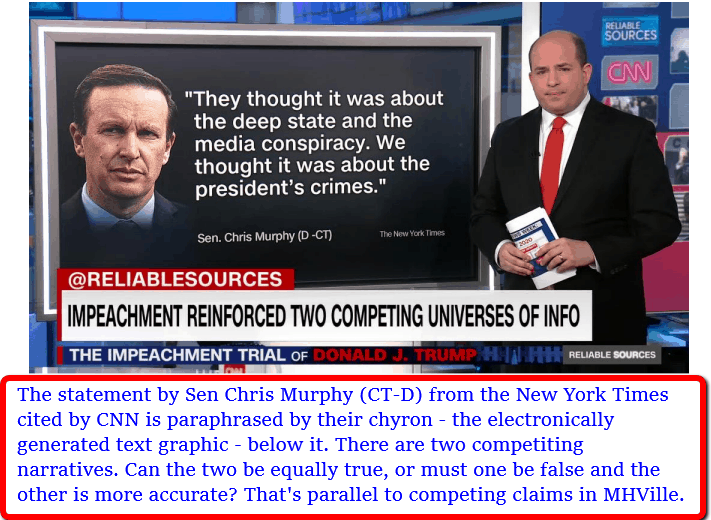
That’s parallel to another similar statement made by former President Barack Obama.
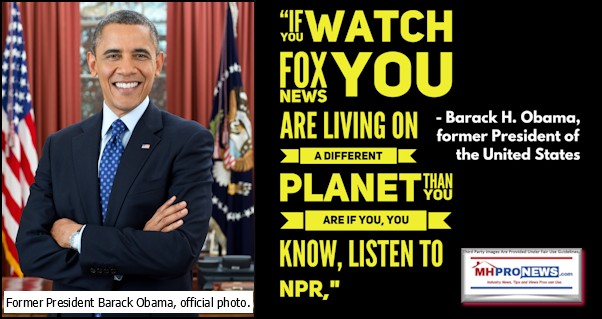
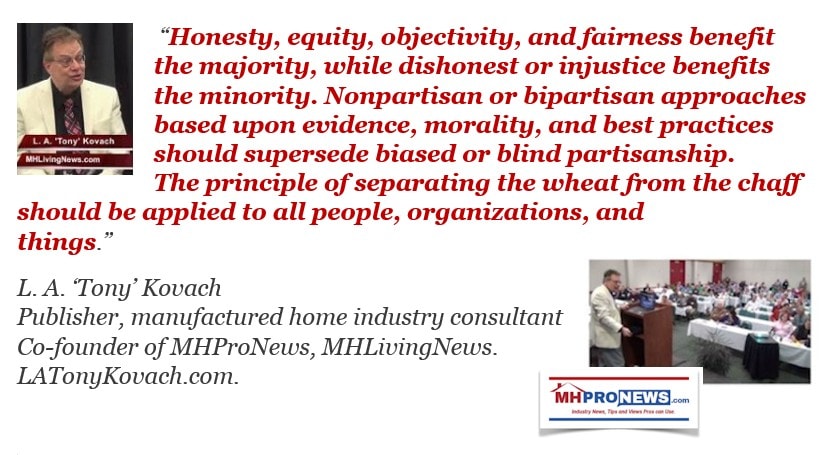
Indeed, there is wide agreement on the former President Obama quote above. For example, Fox News’ Sean Hannity – clearly from a different viewpoint than the former president, has at various times cited prior president Obama’s statement.
Right or wrong, there are broadly speaking two competing narratives in America. More precisely there are several, but they are often boiled down to two.
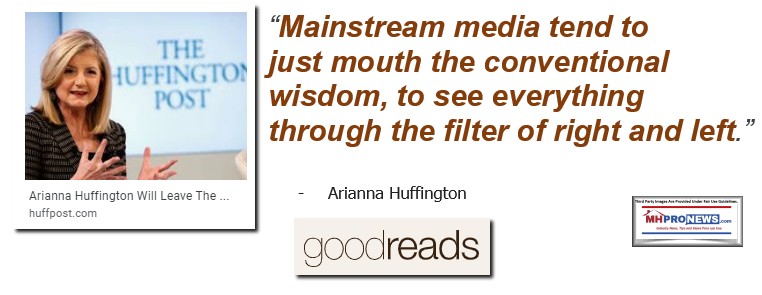
That noted, is there any reason to be surprised that there are competing narratives in manufactured housing? MHI is spinning one storyline, while MHARR is advancing another that is quite different. For thinkers, that begs the question. Which narrative – MHI’s or MHARR’s – happens to be closer to reality? Which storyline is more based upon spin or an unstated agenda?
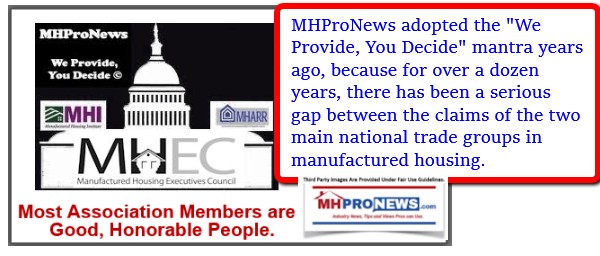
Day by day – as the weeks, months and years have rolled by – MHProNews has been increasingly focused on analyzing the competing claims being advanced, not only by MHI or MHARR, but also by various trade media or bloggers in manufactured housing. The reasons for that are simple. The industry is underperforming during an affordable housing crisis.
Yesterday’s report – linked below – highlighted that disparity between MHI and MHARR on a key issue for the industry in a simple yet profound manner. MHI completely ignored the topic of financing which should have been part of their report, because it is of vital importance to thousands of manufactured housing independents. MHI and MHARR were both invited to a meeting with the Federal Housing Finance Agency (FHFA) regarding the Duty to Serve manufactured housing lending mandated by the Housing and Economic Recovery Act (HERA) of 2008. Both national trade groups were among several other interested parties invited to the same meeting with FHFA Director Mark Calabria. Which begs the question. Why did MHI decide not to tell their members about this meeting? Why did MHARR go into some detail on the issue MHI ignored? Note that neither trade group likely knew what the other would say, because the messaging from both came out at very similar times on the same date.
MHI claims they want more lending on HUD Code manufactured homes. Indeed, they could provide ‘evidence’ that they want more financing options. They could just point to some of their statements about FHA Title I lending in their RFI comments letters, for example.
But for whatever reason, MHI – which claims to represent all segments of manufactured housing – has failed to get the FHFA to implement a law that already exists that mandates exactly that requirement. Namely, that Fannie Mae and Freddie Mac providing robust lending for all of the inherently affordable HUD Code manufactured homes, not just some so-called ‘new class’ of homes finally named last year “CrossModTM homes” that happens to be promoted by Clayton Homes and their allies.
If one believes the research that MHI has paid for, then those “CrossModTM homes” ought to be taking off in the marketplace.
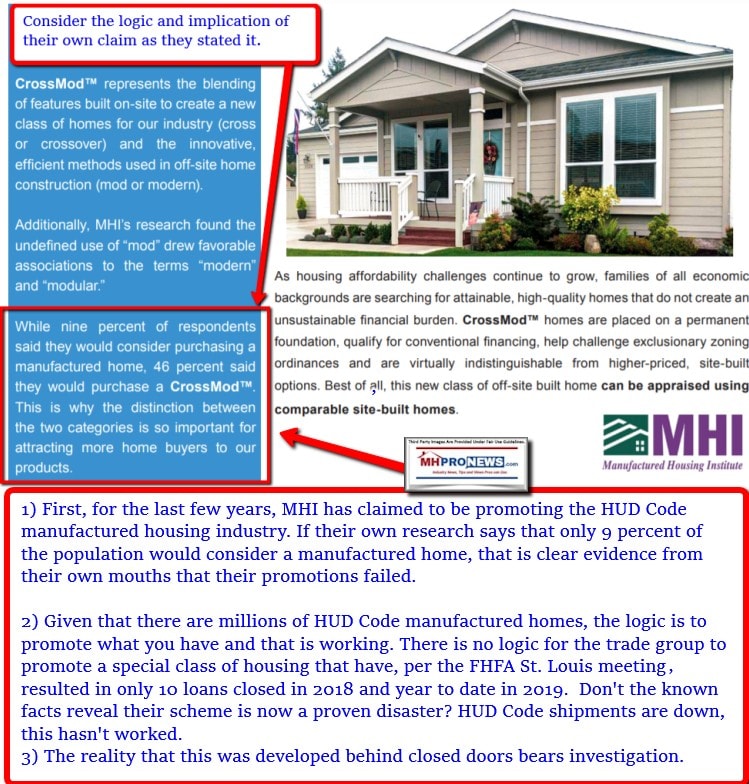
But in fact, new HUD Code manufactured home shipments declined in 2019 vs. 2018.
On important issue after issue, MHI and their big boy backers and supportive bloggers seem to repeatedly be on the wrong side of history. By contrast, MHARR is routinely advocating for the correct principle. Why is that so?
The simplest explanation is that MHI as it is currently organized and operated exists primarily to consolidate manufactured housing into ever fewer hands. Those ‘big boy’ and ‘insider’ brands are apparently satisfied with the status quo. They get to consolidate the industry at a discounted or cheaper valuation than if manufactured housing were operating as it ought to be absent purported illicit schemes and market manipulation. Even one of their bloggers has admitted as much.
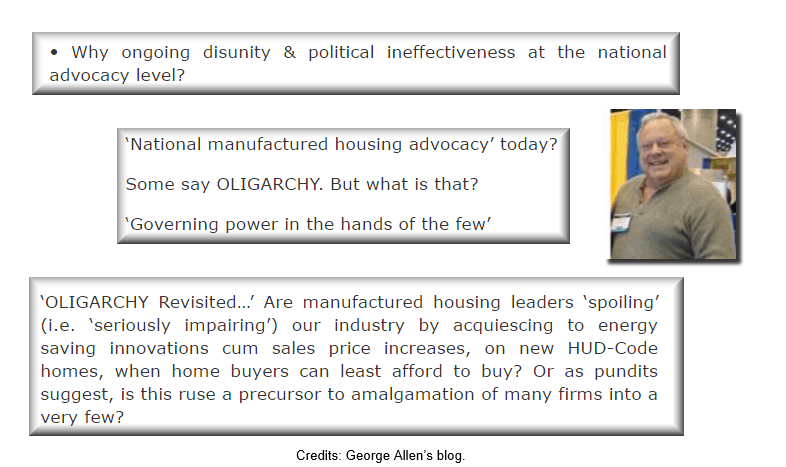
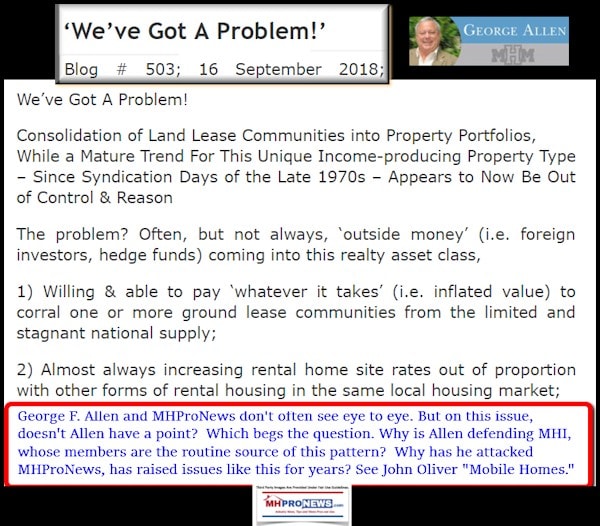
MHI and their leaders will not directly engage in a discussion or debate on those issues. Indeed, to avoid even a brief possibility of that occurring, for 2 years running, MHI’s surrogates arguably stopped MHProNews from attending the Louisville Show. We have documentary evidence that they literally barred our publication from attending.
Prior to barring us from Louisville attendance, MHI ejected MHProNews from membership in their trade group, after 7 years of membership. Their stated reason? In an unsigned letter, they said they discovered that we were news – trade media – and they had no such membership category. That was a red herring, because others publish too. Furthermore, MHI well knew that we do more than publish, we provide an array of marketing, educational and professional services. Indeed, MHI and their leaders praised those services and praised our publications.
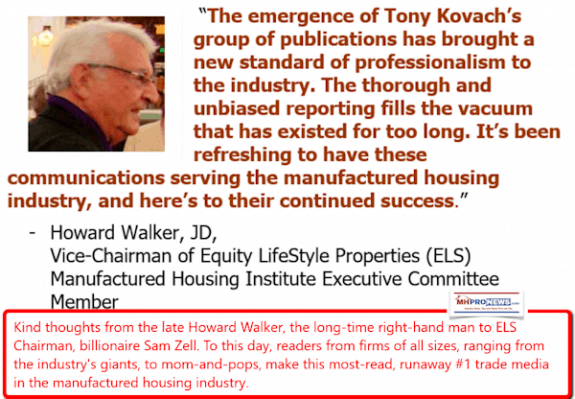
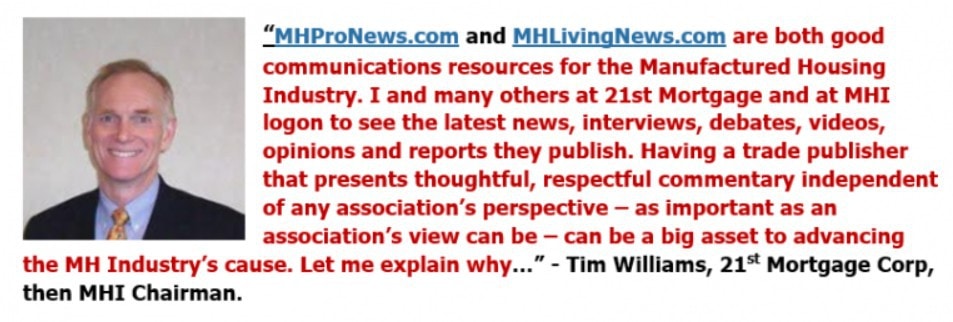
Rephrased, MHI’s behavior – which is obviously based on the instructions of their leadership – was revealing. While their true rationale was quickly evident to us – they wanted to publicly avoid the tough questions that might reveal their purported duplicity. But understanding something is true can be different than proving a case. Some things take time to demonstrate and document with solid evidence.
MHI and their ‘big boy’ and ‘insider’ bosses can run, but they can’t hide. By doggedly sticking to facts, evidence and rationale analysis, MHProNews has step-by-step documented the ways that they have purportedly undermined manufactured housing from within.
That has been aided in significant ways by news tips from insiders who for several years have been providing key evidence that documents just how purportedly duplicitous MHI and their corporate bosses are. A recent example of that are the documents that were provided to MHProNews from a connected source that made is clear that Lesli Gooch is engaged in apparent conflicts of interest. ICYMI, see the evidence shown in the report linked below.
Whistleblower’s Documents on Lesli Gooch – Manufactured Housing Institute CEO – New Discoveries
Faced with those allegations and growing evidence, MHI’s leadership has done zero in the way of a direct response. Instead, they pretend like MHARR and MHProNews doesn’t exist. They also act like there are no dissenting voices in their organization. But the evidence of that dissent is proven by the fact that tips periodically come in that are embarrassing to MHI, Clayton Homes, 21st and others. An example is posted below. That item was once published on MHI’s website. Now, now more. Why? Is it because it doesn’t fit their new narrative and strategy?
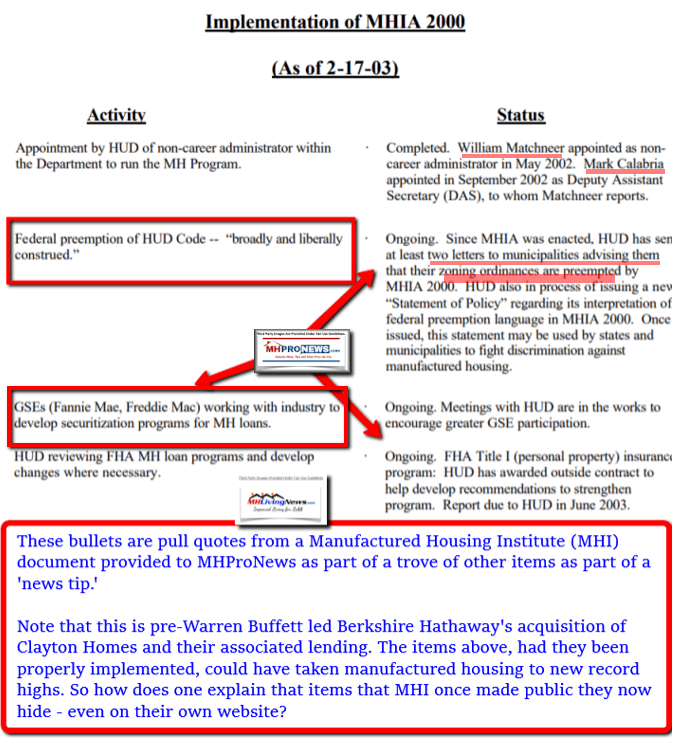
So, on issue after issue, what certain leaders, their surrogates and MHI posture are demonstrably untrue. Rephrased, the case can be made that MHI and their leaders arguably lie and attempt to deceive even their own members on an ongoing basis. They do so with some cover from much of the balance of the industry’s bloggers and slick looking published media.
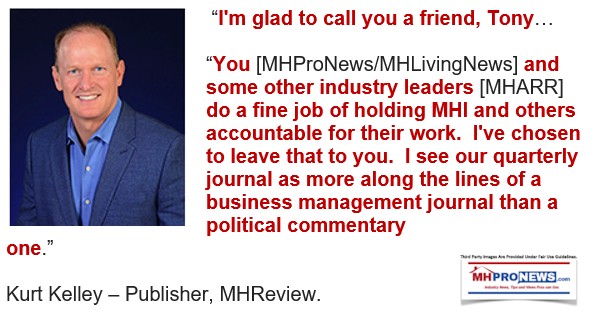
MHProNews did an in depth interview with Mark Weiss, J.D., President and CEO of MHARR related to issues that he knows about first hand, because he was there when the Manufactured Housing Improvement Act was passed into law. No one at MHI’s Arlington offices can honestly make that same statement. MHARR was pushing for the Duty to Serve in 2008. On issues of importance, MHARR’s president and CEO has insights that would be difficult for MHI to dispute.
But what about from inside MHI?
This week, MHProNews published a revealing look at positions and statements made by Randy Rowe of Green Courte Partners. It is juxtaposed with insights from others at MHI, including Tim Williams/21st Mortgage, Terry Decio/Skyline and others.
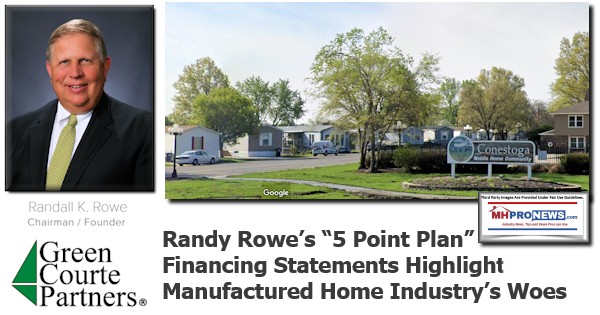
The best the Omaha-Knoxville-Arlington axis can do is arguably create illusions of an alternative reality. They won’t debate that, nor will their outside attorneys debate that claim or others like it. If they were so correct, why do they duck such a discussion?
Clayton Homes, 21st Mortgage, MHVillage, Manufactured Housing Institute Leaders Challenged
MHI could send Rick Robinson and a colleague to meetings to ‘promote’ manufactured housing for years on end. But what did that travel and expense actually accomplish for manufactured housing independents?
Doesn’t the latest shipment data prove that MHI’s ineffective at their own stated claims?
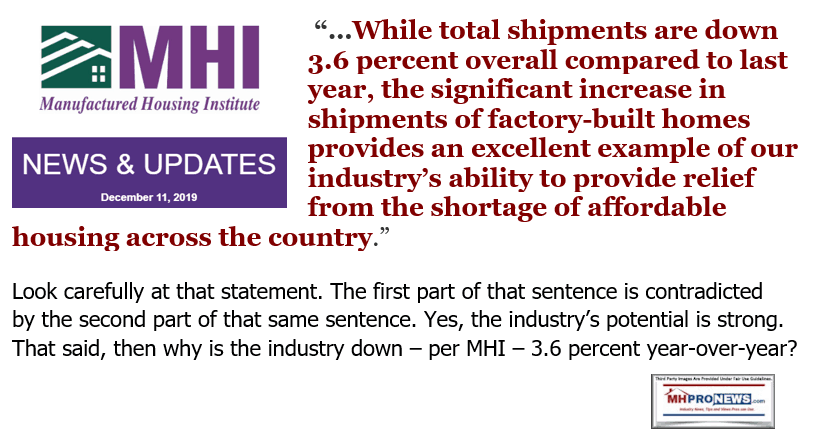

In law enforcement, in investigative journalism and in certain kinds of legal work, simple principles are used.
- Who benefits from a certain behavior?
- Follow the money.
- Pay more attention to what people do than to what they say.
Some of that sounds suspiciously like what award winning journalist Sharyl Attkisson has said is the true role of new media. But agenda journalism, as the CNN illustration above illuminates, clearly abounds.

For the purpose of this report, we don’t have to sort out who in politics or media is generally closer to the truth. But this report helps once more to shine a light on how the Omaha-Knoxville-Arlington axis and their allies have routinely and for years arguably used head fakes and deceptive tactics, all told with a smile at meeting in nice resort hotels while people are socializing, having drinks and fun. This isn’t new, it goes back years before the current team at MHI was in place.
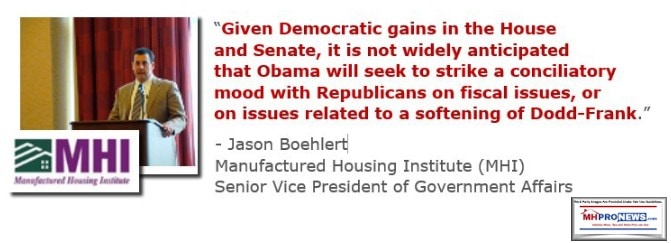
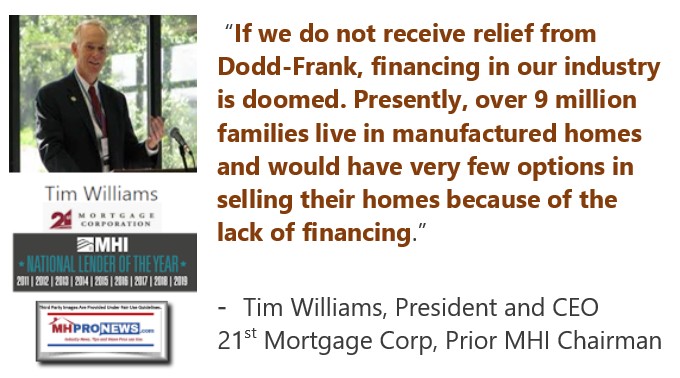
Rephrased, MHI’s leaders have arguably deployed numerous methods of manipulation and deception. Those methods arguably have a simple aim. To defraud people of their opportunities in a manner that allows a few to benefit, while others arguably get cheated of what they could make earn in the absence of such manipulation. That forms the basis for several possible legal actions, including RICO.

The evidence has been and continues to be laid out, step by step thanks to sources, tips, MHARR, others — plus our own research, investigations and publishing at MHProNews. MHI and their big boys won’t challenge that evidence publicly. Why not? Why have they ducked it for years? The debatable logical answer is that if they debated or directly engaged with us publicly, they would lose, because the facts and evidence are on our side, not theirs.
If they lost a debate publicly, then their con-game would be even more exposed than it already is. Then, they would presumably have to face legal consequences. So instead, they play the pretend MHARR, MHProNews et al don’t exist. They try to bar MHProNews from as many events as they can. But where they can’t stop us, they get publicly challenged by the facts. That occurred in Washington, D.C. on December 2nd, 2019. Did they report that to their readers? No.
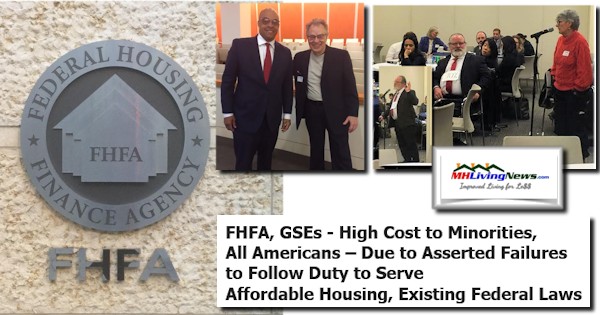
That said, state and federal investigators are already on the trail. ICYMI, see the report linked below.
Elected public officials are increasingly on the trail of those who are MHI insiders who behave in problematic ways. Indeed, there is evidence that Berkshire brands have deployed behavioral science in ways that could be described as subtle to bold forms of manipulation.
Perhaps it is no coincidence, then, that the Federal Trade Commission (FTC) has been asked to investigate certain practices tied to specific MHI members. These growing numbers of federal and state investigations tend to support the MHProNews contention that deceptive trade practices have been used against thousands of manufactured home industry independently owned companies.

Why is MHProNews the runaway most read trade publication in manufactured housing? The case can be made that it is because we lay out the facts, sometimes with humor, but always putting forth the evidence and reason that supports the statements being made.
Be it so-called ‘excellence’ awards or whatever, by accident or design, MHI and their masters use techniques that are documented to be effective by criminal investigators.
The wheels of justice grind slowly. But they can work. Bernie Madoff is in federal prison, asking to be released because he says he is dying. Madoff was once a respected billionaire with his own array of connections.
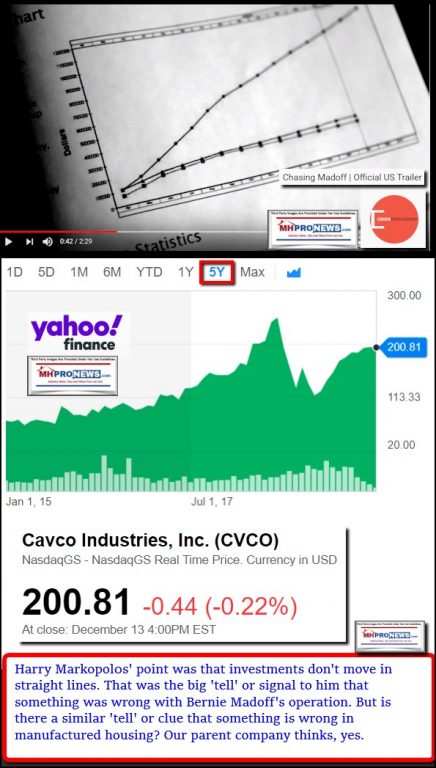
Now, Madoff is in a prison cell. Was it worth it?

Back in the late 1990s, and early 2000s, there were periodic stories about manufactured home professionals that were arrested for various forms of credit fraud. Some were charged and arrested, tried or plead guilty and then sentenced to prison. Do you think that there is concern over that possibly occurring among the key members of the axis?
There are reasons for the industry’s independents to take steps that can accelerate the process of justice. It begins with having a clear understanding of what has gone wrong in manufactured housing since 2003. Then, it continues by understanding the various ways that MHI and their big boy allies have arguably systematically attempted to deceive thousands.
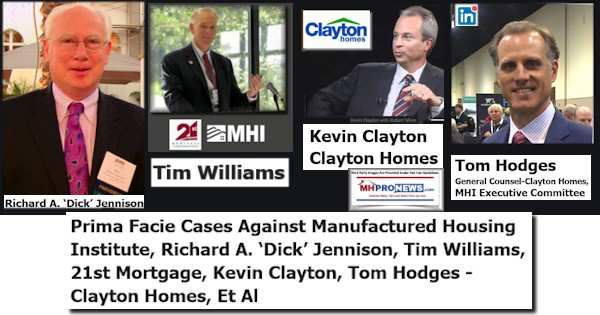
Sounds far-fetched? Ask President Donald Trump and Speaker Nancy Pelosi. The lesson of the CNN and former President Obama statements referenced earlier point to a vexing reality that the big lie method is at work in America. We’ll leave it for another time to sort out the truth of those big lies being told at the national level.
But if big lies are being told repeatedly in Washington, then why would it be hard to believe that it is occurring in the artificially downsized manufactured home industry? Just monitor the statements of MHI’s own leaders, past and present, and compare them. They arguably reveal a pattern of paltering, self-contradiction, spin, and deception.
Who benefits? Consolidators.
The case is being made that those big lies are not only being told by industry insiders, it includes a degree of cover from specific federal officials at agencies like HUD and the FHFA. There is a growing body of evidence for that claim too.
That’s plenty to digest, but wade through that critically – meaning analytically. See where the logic and the evidence take you. See why MHI would seemingly rather than MHProNews, MHARR or those others who are the ‘resistance’ inside their own organizations would just magically all go away. Pretending we don’t exist is a sign of intellectual weakness. Pretending that there is evidence against them is like saying, those thousands of independent retailers and communities that were arguably undermined by Clayton Homes and 21st Mortgage didn’t exist.
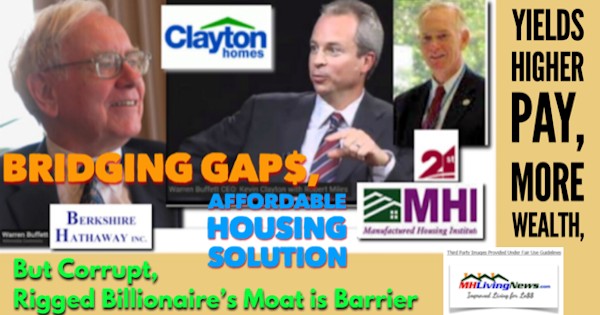
But those thousands of independent manufactured home retailers and communities did exist. Numbers of once successful producers are gone due to the machinations that are evidenced in the report linked above. Day by day, month by month, the case is being made that Berkshire brands and their MHI connected allies were logically victimizing thousands of businesses and investors in a different manner than Bernie Madoff’s victims were, but it was no less harmful.
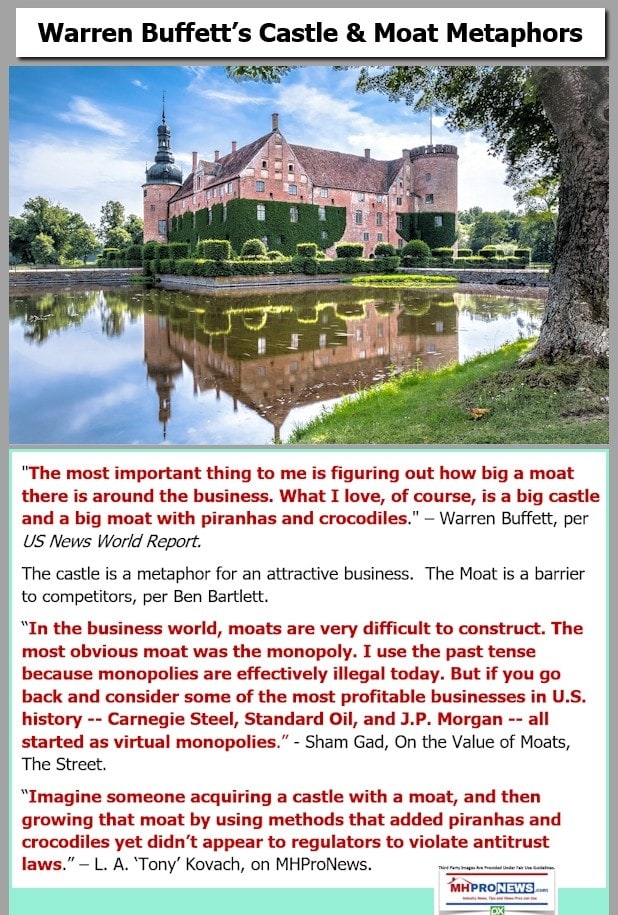
Before closing, one more noteworthy point. For months, one of the top read articles on the MHProNews site is this one linked below. More than 5 months have elapsed since that report was published. It is still dwarfs those in readership published by MHInsider or others. Industry professionals don’t want BS. They want straight talk. That article linked below is being read and re-read by industry professionals, and we think, by various investigators. If it has been a while since you’ve read it, see how it laces up with this report.
Investigators and you should read and re-read this report too. It takes time to digest the details. Lance Inderman said it well when he quoted Mark Twain.
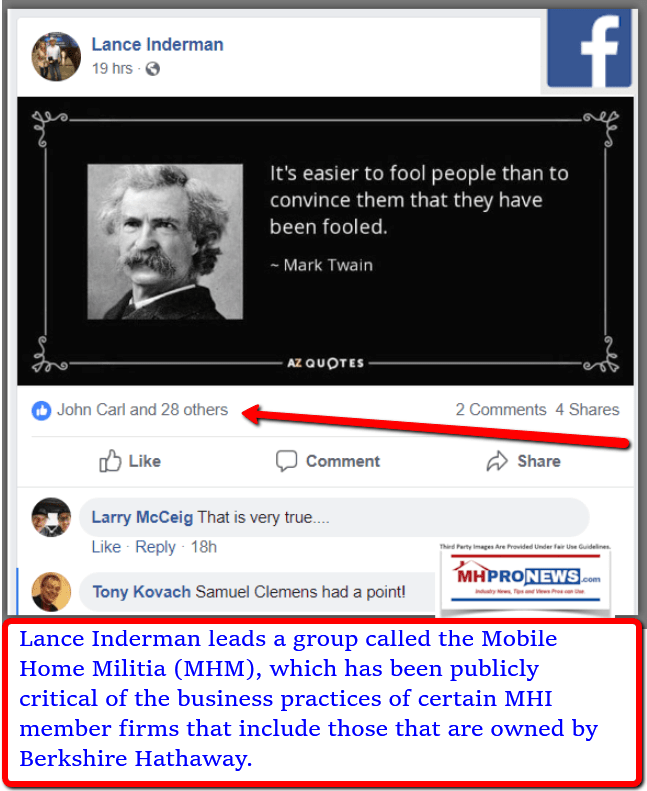
Because the system in manufactured housing is apparently rigged against the independents of the industry. This writer is willing to meet with MHI’s attorneys and leadership to debate these issues and evidence publicly in front of a live audience of industry professionals with an agreed upon third-party moderator.
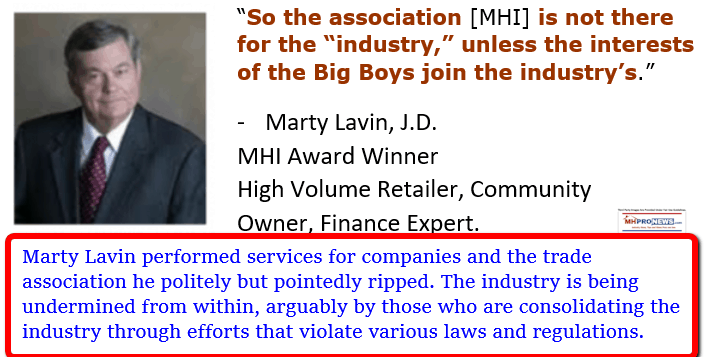
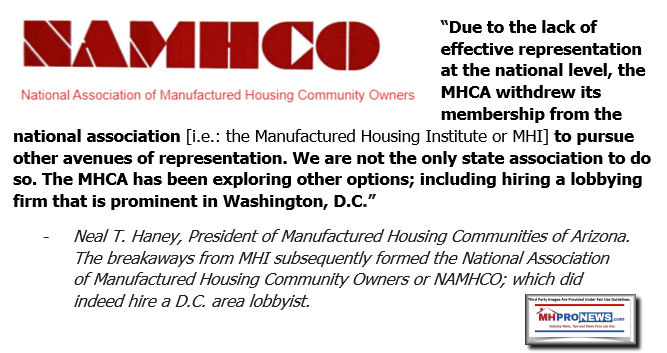
Will MHI and their leaders do so? Time will tell. But until then, forewarned is forearmed. The next phase of the justice for wronged manufactured housing professionals, investors, independent business, and consumers plan is being established. They have photo ops, ‘razzle dazzle’ videos that few actually watch, surrogates that put forth their narrative – all supported by deep pockets. Meanwhile, we have facts, evidence, reason and resolve. It will be epic David vs. Goliath. Let’s see what happens next.
The 45th president has been acquitted. Following a week of turmoil in Iowa, tonight there is another Democratic debate. Just as we watch what is occurring in manufactured housing, we monitor and report on those macro issues too.
Oh, yes. That promised teaser? Sometime soon, perhaps by the end of next week, there will a new report on an another manufactured housing focused issue that is missing from both MHI and MHARR’s weekly reports above. That report requires some additional research before we roll it out for industry professionals. Stay tuned.
That’s it for now on this installment of manufactured home “Industry News, Tips and Views Pros Can Use,” © where “We Provide, You Decide.” © (Affordable housing, manufactured homes, reports, fact-checks, analysis, and commentary. Third-party images or content are provided under fair use guidelines for media.)

(See Related Reports, further below. Text/image boxes often are hot-linked to other reports that can be access by clicking on them.)
By L.A. “Tony” Kovach – for MHLivingNews.com.
Tony earned a journalism scholarship and earned numerous awards in history and in manufactured housing. For example, he earned the prestigious Lottinville Award in history from the University of Oklahoma, where he studied history and business management. He’s a managing member and co-founder of LifeStyle Factory Homes, LLC, the parent company to MHProNews, and MHLivingNews.com. This article reflects the LLC’s and/or the writer’s position, and may or may not reflect the views of sponsors or supporters.
Connect on LinkedIn: http://www.linkedin.com/in/latonykovach
Related References:
The text/image boxes below are linked to other reports, which can be accessed by clicking on them.
